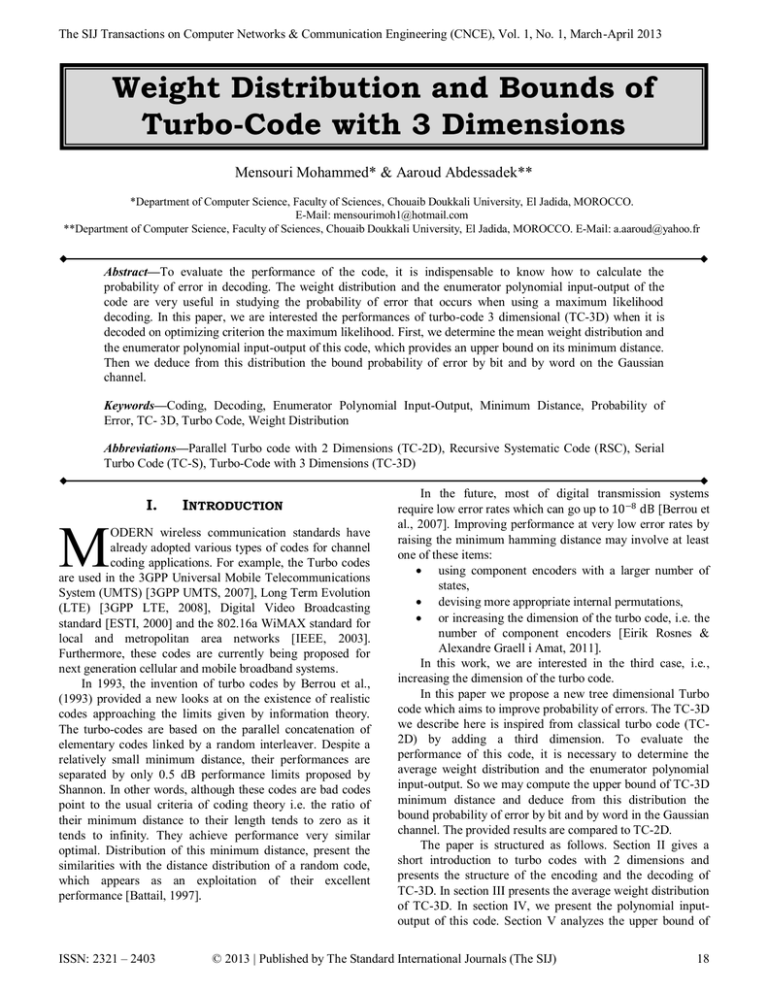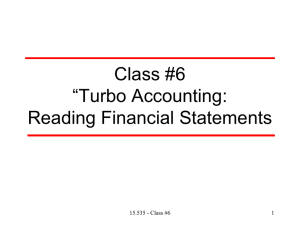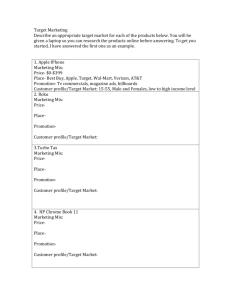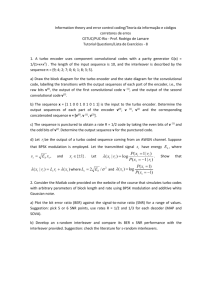Document 14544834
advertisement

The SIJ Transactions on Computer Networks & Communication Engineering (CNCE), Vol. 1, No. 1, March-April 2013 Weight Distribution and Bounds of Turbo-Code with 3 Dimensions Mensouri Mohammed* & Aaroud Abdessadek** *Department of Computer Science, Faculty of Sciences, Chouaib Doukkali University, El Jadida, MOROCCO. E-Mail: mensourimoh1@hotmail.com **Department of Computer Science, Faculty of Sciences, Chouaib Doukkali University, El Jadida, MOROCCO. E-Mail: a.aaroud@yahoo.fr Abstract—To evaluate the performance of the code, it is indispensable to know how to calculate the probability of error in decoding. The weight distribution and the enumerator polynomial input-output of the code are very useful in studying the probability of error that occurs when using a maximum likelihood decoding. In this paper, we are interested the performances of turbo-code 3 dimensional (TC-3D) when it is decoded on optimizing criterion the maximum likelihood. First, we determine the mean weight distribution and the enumerator polynomial input-output of this code, which provides an upper bound on its minimum distance. Then we deduce from this distribution the bound probability of error by bit and by word on the Gaussian channel. Keywords—Coding, Decoding, Enumerator Polynomial Input-Output, Minimum Distance, Probability of Error, TC- 3D, Turbo Code, Weight Distribution Abbreviations—Parallel Turbo code with 2 Dimensions (TC-2D), Recursive Systematic Code (RSC), Serial Turbo Code (TC-S), Turbo-Code with 3 Dimensions (TC-3D) M I. INTRODUCTION ODERN wireless communication standards have already adopted various types of codes for channel coding applications. For example, the Turbo codes are used in the 3GPP Universal Mobile Telecommunications System (UMTS) [3GPP UMTS, 2007], Long Term Evolution (LTE) [3GPP LTE, 2008], Digital Video Broadcasting standard [ESTI, 2000] and the 802.16a WiMAX standard for local and metropolitan area networks [IEEE, 2003]. Furthermore, these codes are currently being proposed for next generation cellular and mobile broadband systems. In 1993, the invention of turbo codes by Berrou et al., (1993) provided a new looks at on the existence of realistic codes approaching the limits given by information theory. The turbo-codes are based on the parallel concatenation of elementary codes linked by a random interleaver. Despite a relatively small minimum distance, their performances are separated by only 0.5 dB performance limits proposed by Shannon. In other words, although these codes are bad codes point to the usual criteria of coding theory i.e. the ratio of their minimum distance to their length tends to zero as it tends to infinity. They achieve performance very similar optimal. Distribution of this minimum distance, present the similarities with the distance distribution of a random code, which appears as an exploitation of their excellent performance [Battail, 1997]. ISSN: 2321 – 2403 In the future, most of digital transmission systems require low error rates which can go up to 10−8 dB [Berrou et al., 2007]. Improving performance at very low error rates by raising the minimum hamming distance may involve at least one of these items: using component encoders with a larger number of states, devising more appropriate internal permutations, or increasing the dimension of the turbo code, i.e. the number of component encoders [Eirik Rosnes & Alexandre Graell i Amat, 2011]. In this work, we are interested in the third case, i.e., increasing the dimension of the turbo code. In this paper we propose a new tree dimensional Turbo code which aims to improve probability of errors. The TC-3D we describe here is inspired from classical turbo code (TC2D) by adding a third dimension. To evaluate the performance of this code, it is necessary to determine the average weight distribution and the enumerator polynomial input-output. So we may compute the upper bound of TC-3D minimum distance and deduce from this distribution the bound probability of error by bit and by word in the Gaussian channel. The provided results are compared to TC-2D. The paper is structured as follows. Section II gives a short introduction to turbo codes with 2 dimensions and presents the structure of the encoding and the decoding of TC-3D. In section III presents the average weight distribution of TC-3D. In section IV, we present the polynomial inputoutput of this code. Section V analyzes the upper bound of © 2013 | Published by The Standard International Journals (The SIJ) 18 The SIJ Transactions on Computer Networks & Communication Engineering (CNCE), Vol. 1, No. 1, March-April 2013 the minimum distance of the code TC-3D. The probability of errors by word and bit on a Gaussian channel are described in Section VI. The paper is summarized in the section VII. CODING STRUCTURE OF TURBO CODE WITH 3 DIMENSIONS II. Generally, a Turbo code with 2 dimensions is composed of a concatenation a series [Eirik Rosnes & Alexandre Graell i Amat, 2011] or in parallel of two codes (C1 ,C2 ), that is called code components, and an interleaver π (see figure 1). While the first code component encodes the information in the original order, the second receives the information in a permuted order. In all norms, the convolutional codes are used as component codes. For more information about TC2D and TC-S, refer to [Benedetto & Montorsi, 1996]. 𝑢 𝐶1 𝑋2 𝜋 𝐶2 Multiplexer 𝑋1 𝑢𝐶ℎ Figure 1 – Structure of Parallel Turbo Codes with 2 Dimensions Cb 2.1. The Coding Structure of TC-3D Figure 2 shows TC-3D using the three components codes C1 , C2 and C3 in parallel that will be used throughout this article to illustrate some fundamental concepts. The three codes are recursive convolutional in nature [Hagenauer & Hoeher, 1994], with a constraint length L = 3 (i.e. memory= 2 ). The overall code is a rate to equal 1 4 code with four output streams. One of the output streams is the information sequence u uncoded. The other three output streams X1 , X2 and X3 in this example are parity sequences corresponding to three codes C1 , C2 and C3 . These three parity streams would be identical if permutations π1, π2 were not used. The sequence u information of length K bits is encoded by TC-3D. This code is realized by the parallel concatenation of three identical coders: C1 = C2 = C3 . They are recursive convolutional in nature, with 8 states and the generator polynomial is: G1 = 1 1 1 G2 = 1 0 1 The information bits u are encoded initially by the encoder C1 to provide the first redundancy bits X1 , then they are interleaved by π1 before being encoded by the encoder C2 and delivering the second redundancy X2 . The message u is then interleaved by π2 before being encoded by the encoder C3 and delivering the third redundancy X3 . For the canal entrance, we send a message u and data redundancy X1 ,X2 and X3 generate with three elementary codes C1 , C2 and C3 . The originality of the encoder is performing an interleaving (π1; π2) on the data u before treatment C2 and C3 encoders so that errors are not corrected by the first encoder will generally be different the errors not corrected by the second and third codes. Finally, the information sequence u and the code sequences X1 , X2 and X3 are multiplexed to form the codeword uCh of length N bits, they are transmitted to the channel. Note that the total code rate of the TC-3D is R = K N , then we can write : (1) 𝑢𝐶ℎ = 𝑢 𝑋1 𝑋2 𝑋3 2.2. Decoding of TC-3D Code In the AWGN channel, the binary information sequence uCh = u X1 X2 X3 N-dimensional bits as input to the channel, produces a sequence uCh′ = u′ X′1 X′2 X′3 the N dimensional bits, the relationship between uCh and uCh′ for the AWGN channel is: (2) 𝑢𝐶ℎ′ = 𝑢𝑐ℎ + 𝐵 Where B is a random sequence representing the “noise” or “error” additive 𝑿𝟏 ′ 𝒖′ 𝒖 𝝅 -1 𝑪𝟏 𝑿𝟐 𝝅𝟏 𝑪𝟐 𝑿𝟑 𝝅𝟐 Multiplexer 𝑿𝟏 𝒖𝑪𝒉 𝑿′𝟐 𝑪−𝟏 𝟏 𝑪−𝟏 𝟐 𝝅1 𝝅2 𝝅 -2 𝑪𝟑−𝟏 𝑪𝟑 Figure 2 – TC-3D constitute from Three Codes C1 , C2 and C3 which are grouped in Parallels 𝑿𝟑 ′ Figure 3 – Schema of TC-3D Decoder ISSN: 2321 – 2403 © 2013 | Published by The Standard International Journals (The SIJ) 19 The SIJ Transactions on Computer Networks & Communication Engineering (CNCE), Vol. 1, No. 1, March-April 2013 Let A1 ω be the number of code words average of C1 and the weight ω. The average weight distribution of TC-3D is denoted C, is obtained by averaging over all random interleavers πi , i = 1,2 of length N. Let P ω be the probability that a sequence of weight ω is a code word C the weight ω, and A(ω) the total number of code words the code C of weight ω. There exists CNω words the weight ω and the length N, so we have the following relationship: 𝑁! 𝐴 𝜔 = 𝐶𝑁𝜔 𝑃(𝜔) with 𝐶𝑁𝜔 = (𝑁−𝜔 )!𝜔 ! (3) Let P1 ω , P2 ω and P3 (ω) be the probability that a sequence of weights ω is a codeword C1 , C2 , C3 respectively. The codes C2 and C3 being permuted versions of the code C1 , probabilities P1 ω , P2 ω and P3 (ω) are identical and equal to P1 ω , so the probability P (ω) can be written: 𝑃 𝜔 = 𝑃1 (𝜔) × 𝑃2 (𝜔) × 𝑃3 (𝜔) (4) Of over: 𝐴1 𝜔 = 𝐶𝑁𝜔 𝑃1 (𝜔) (5) The mean distribution of the weight of TC-3D code is given by the following relationship: Aω= (A1 (ω))3 (CNω )2 (6) Weight distribution A1 ω of C1 convolutional code can be calculated using the transition matrix T raised to the power W, where W is the number of branches in the trellis code [Divsalar et al., 1995]. The previous formula was applied to a code of length N = 200 constructed from two recursive systematic codes (RSC) of rate 1⁄2 and generator polynomial G1 and G2, for calculate the weight distribution A ω : G1 = 1 1 1 G2 = 1 0 1 ISSN: 2321 – 2403 w A(w) w A(w) w A(w) w A(w) 5 1,24E-81 12 3,00E-72 19 8,75E-65 26 1,49E-58 6 4,05E-80 13 4,34E-71 20 7,92E-64 27 3,06E+31 7 1,12E-78 14 5,79E-70 21 6,79E-63 28 1,89E+32 8 2,70E-77 15 7,18E-69 22 5,52E-62 29 1,12E+33 9 5,77E-76 16 8,30E-68 23 4,28E-61 30 6,40E+33 10 1,10E-74 17 8,99E-67 24 3,15E-60 11 1,90E-73 18 9,14E-66 25 2,22E-59 This weight distribution is compared to turbo code with two dimensions for N=200 in Figure 4. The two distributions are shown in Figure 4. TC-3D 6.00E+57 TC-2D 5.00E+57 4.00E+57 3.00E+57 2.00E+57 1.00E+57 0.00E+00 1 14 27 40 53 66 79 92 105 118 131 144 157 170 183 196 III. AVERAGE WEIGHT DISTRIBUTION Table 1 – Average Weight Distribution of TC-3D Number of Codewords: A(ω) The TC-3D can be decoded using the turbo principle. The decoder of TC-3D consists of three soft-input soft-output [Yannick Saouter, 2010] decoders C1−1 , C2−1 , and C3−1 corresponding to the three constituent encoders C1 , C2 , and C3 , respectively. A decoding iteration consists of a single activation of C1−1 , C3−1 , and C2−1 , in this order. This process continues iteratively until the maximum number of iterations is reached or an early stopping rule criterion is fulfilled. These three decoders exchange extrinsic information [Battail, 1997] on the systematic bits u’ and the parity bits Xa ′,Xb ′ and Xc′ This extrinsic information exchange is referred as turbo principle. Figure 3 shows a possible decoder realization. The three component decoders perform a maximum a posteriori probability (MAP) decoding on bit. They use the BCJR algorithm transformed in the logarithmic domain, the so called Log MAP algorithm [Robertson et al., 1995], to decrease the implementation complexity. Weight of Codewords: ω Figure 4 – Comparison of Weight Distribution TC-3D Code and the Weight Distribution of a Turbo Code in Two Dimensions for N=200 IV. POLYNOM ENUMERATOR INPUT-OUTPUT OF TC-3D To simplify the study, we assume throughout this subparagraph the three coders C1 , C2 and C3 are RSC and identical i.e. C1 = C2 = C3 . Their rate is R1 = R 2 = R 3 =1⁄2. The rate of the resulting TC-3D is equal to R=1/4. Trellis termination is neglected, and we denote by Nπ the size of the interleaver. The enumerator polynomial input-output code C1 wrote: 𝑁𝜋 𝐴 𝐶1 𝑁𝜋 𝐶 𝐴𝑖,𝑧1 𝐼𝑖 𝑍 𝑧 𝐼, 𝑍 = (7) 𝑖=𝑖𝑚𝑖𝑛 𝑧=𝑧 𝑚𝑖𝑛 C Where Ai,z1 is the number of codewords C1 corresponding to a weight of information i and the weight parity z. The polynomial AC 1 I, Z does not include the word 0, ..., 0. For a RSC code which trellis is closed, the minimum weight input is imin . The minimum weight output zmin does not necessarily correspond to minimum weight input imin ; if we ′ note zmin the weight of the parity corresponding to the weight input imin , then in general: ′ 𝑧𝑚𝑖𝑛 ≤ 𝑧𝑚𝑖𝑛 C1 The polynomial A I, Z can also be written as follows: © 2013 | Published by The Standard International Journals (The SIJ) 20 The SIJ Transactions on Computer Networks & Communication Engineering (CNCE), Vol. 1, No. 1, March-April 2013 𝑁𝜋 𝐴 𝐶1 𝑖 𝐼, 𝑍 = 𝐼 𝐴 𝐶1 (8) 𝑖, 𝑍 Consequently, an upper bound is given by ρ, the smallest integer satisfying: 𝜌 𝑖=𝑖𝑚𝑖𝑛 With 𝑤=1 (9) 𝐴𝑖,𝑧1 𝑍 𝑧 𝑧=𝑧 𝑚𝑖𝑛 Where AC 1 i, Z is called conditional weight enumerator polynomial because the weight of the input i is fixed. A method for calculating this polynomial is presented in Benedetto & G. Montorsl (1996) and Battail (1997). The conditional weight enumerator polynomial conditional TC-3D considered is calculated by averaging over all possible interleavers. The interleaver TC-3D is random; three encoders’ inputs are independent. Therefore it is easily verified: (𝐴𝐶1 𝑖, 𝑍 )3 𝐴𝐶 𝑖, 𝑍 = (10) (𝐶𝑁𝑖 𝜋 )2 SUPERIOR BOUND OF THE MINIMUM DISTANCE OF TC-3D CODE The average weight distribution of TC-3D code provides an upper bound ρ of its minimum distance dH min for a length code N fixed. In fact, 𝑃𝑟 𝑑𝐻 𝑚𝑖𝑛 ≤ 𝜌 = Pr(∋ 𝑣 ∈ (𝐺𝐹 2 )𝑁 , (11) 𝜔𝑣 ≤ 𝜌, 𝑣𝜖 𝐶) Where ωv denotes the weight of the sequence v. The terminal of the union applied to this equality gives: 𝜌 𝑃𝑟 𝑑𝐻 𝑚𝑖𝑛 ≤ 𝜌 ≤ 𝑃𝑟(∋ 𝑣 𝑖=1 𝑁 (12) ∈ (𝐺𝐹 2 ) , 𝑣𝜖 𝐶, 𝜔𝑣 = 𝑖) But there are M = CNi the sequences of weight i in (GF 2 )N denoted s1 , … , sM thus: 𝜌 𝑃𝑟 𝑑𝐻 𝑚𝑖𝑛 ≤ 𝜌 ≤ 𝑃𝑟((𝑠1 𝜖 𝐶, 𝜔𝑠1 𝑖=1 Let, 𝑃𝑟 ( 𝑠𝑗 𝜖 𝐶, 𝜔𝑠𝑗 = 𝑖) ρ 𝐶𝑁𝑖 𝑃(𝑖 ) ≤ (15) i=1 𝜌 (16) 𝑖=1 ρ ≤ A(i) i=1 ISSN: 2321 – 2403 70 60 50 40 30 20 10 0 100 200 300 400 500 600 700 800 Length N (14) The probability Pr(sj ϵ C, ωsj = i) is by definition to equal to the probability P(i),∀ j, hence: M P(i) TC-2D More than the same values of the superior bound ρ, it is interesting to note on this figure, the nature of the evolution of ρ as a function of N. Indeed, in the case of TC-3D this evolution is higher than the turbo-code parallel and serial with 2 dimensions. For the turbo code with two dimensions, distance varies very little as a function the length N of the code. This behavior is similar to the results of the minimum distance presented by Kahale & Urbanke (1998). 𝑖=1 𝑗 =1 Pr dH min ≤ ρ ≤ TC-S 80 Figure 5 – Evolution the Superior Bound ρ of Minimum Distance 𝑀 𝑃𝑟 𝑑𝐻 𝑚𝑖𝑛 ≤ 𝜌 ≤ Figure 5 represents evolution the superior bound ρ of the minimum distance for lengths codes from N=100 to N=800, total rate R = 1/4 and pseudo-random interleaving, in the three following cases: TC-3D Parallel Turbo code with 2 dimension (TC-2D) Serial Turbo Code ( TC-S) (13) = 𝑖) ∪ 𝑠2 ∈ 𝐶, 𝜔𝑠2 = 𝑖 ∪ … ∪ (𝑠𝑀 𝜖 𝐶, 𝜔𝑠𝑀 = 𝑖)) 𝜌 Table 2 – Presents some Values of 𝜌 for the TC-3D Code for Different Length 𝑁 Superior Bound 𝝆 Length N 100 36,840 200 46,416 300 53,133 400 58,480 500 62,996 600 66,943 700 70,473 800 73,681 Superior Bound ρ 𝐶 𝐴𝐶1 𝑖, 𝑍 = V. (18) 𝐴(𝜔) = 1 𝑁𝜋 (17) VI. PROBABILITY OF ERROR ON THE GAUSSIAN CHANNEL The average weight distribution of the TC-3D code can also enable us to deduce bounds for the error probability of this code on the AWGN channel. Indeed, the interleavers in TC3D code act on all the bits coded such that all bits coded are equally protected. The probability of error by word 𝑃𝑒𝑊 and © 2013 | Published by The Standard International Journals (The SIJ) 21 The SIJ Transactions on Computer Networks & Communication Engineering (CNCE), Vol. 1, No. 1, March-April 2013 bit 𝑃𝑒𝑏 are then obtained by applying the bound of the union and increased by: 𝑁 𝑃𝑒𝑊 ≤ 𝜔 ൌ𝑑 ͳ 𝑁 𝑃𝑒𝑏 ≤ 𝜔 ൌ𝑑 ͳ 𝐴 𝜔 𝑄 𝜔 𝐴 𝜔 𝑄 𝑁 ʹ𝐸𝑏 𝑅𝜔 𝑁Ͳ 𝑅𝜔 [2] (19) [3] ʹ𝐸𝑏 𝑁Ͳ (20) Where 𝐸𝑏 𝑁Ͳ is signal-to-noise ratio average by bit and 𝑄ሺ𝑥ሻ denotes the error function. Figure 6 shows the probability of error by bit obtained after decoding the code TC-3D, the rate 𝑅 ൌ1⁄4 constructed from convolutional code for K=1024 bits, K=3072 bits and K=6148 bits. [4] [5] [6] -1 10 simulation0 K=1024 simulation0 K=3072 K=6144 simulation0 -2 10 [7] [8] -3 BER 10 [9] -4 10 [10] -5 10 [11] -6 10 [12] -7 10 0 1 2 3 Eb/N0 (dB) 4 5 6 Figure 6 – Probability of Error by Bit for K=1024 bits, K=3072 bits and K=6148 bits Let us note that bounds more precise at low signal-tonoise ratios can be considered to estimate the probability of error by word and bit. VII. CONCLUSION To estimate the performance of a code, it is necessary to have information on its minimum distance and the probability of error. The weight distribution and enumerator polynomial of the code are very useful for studying these performances. In this paper we have calculated the weight distribution and enumerator polynomial input-output of TC-3D to evaluate their minimum distance and their error probability. The results found are compared to the turbo-code with 2 dimensions. We deduce from these results (Figure 4 and Figure 5) that the performances of TC-3D are better than those of the turbo-code with 2 dimensions. In the future work, we will study the relationship between the inputs and the outputs of our code, i.e. the transfer function. REFERENCES [1] C. Berrou, A. Glavieux & P. Thitimajshima (1993) “NearShannon Limit Error-Correcting Coding and Decoding: TurboCodes”, IEEE International Conference on Communications ISSN: 2321 – 2403 [13] [14] [15] (ICC '93), Geneva. Technical Program, Conference Record, Pp.1064-1070. J. Hagenauer & P. Hoeher (1994), “A Viterbi Algorithm with Soft-Decision Outputs and its Applications”, Proceedings /IEEE Globecom Conference, Vol.3, Pp. 1680-1686. P. Robertson, E. Villebrun & P. Hoeher (1995), “A Comparison of Optimal and Sub-Optimal MAP Decoding Algorithms Operating in the Log-Domain”, Proceeding/ International Conference on Communications (ICC ’95), Vol.2, Pp. 1009-1013. D. Divsalar, S. Dolinar & F. Pollara (1995), “Transfer Function Bounds on the Performance of Turbo Codes”, TDA Progress Report 42-122, Pp. 44-55. S. Benedetto & G. Montorsl (1996), “Unveiling Turbo Codes: Some Results on Parallel Concatenated Coding Schemes”, IEEE Transaction on Information Theory, Vol. 42, No. 2, Pp. 409-429. S. Benedetto & G. Montorsi (1996), “Serial Concatenation of Block and Convolutional Code”, Electronic Letters, Vol.32, No.10, Pp.887-888. G. Battail (1997), “Théorie d’Information”, Masson, Paris. N. Kahale & R. Urbanke (1998), “On the Minimum Distance of Parallel and Serially Concatenated Code”, Proceeding/IEEE International Symposium on Information Theory, Pp.31. ESTI (2000), “Digital Video Broadcasting (DVB); Interaction Channel for Satellite Distribution Systems”, ETSI EN 301 790, V1.2.2, Pp.20-24 IEEE (2003), “IEEE Standard for Local and Metropolitan Area Networks”, IEEE 802.16a. 3GPP UMTS (2007), “General UMTS Architecture”, 3GPP TS 23.101 version 7.0.0. C. Berrou, A. Graell i Amat, Y. Ould Cheikh Mouhamedou, C. Douillard & YSaouter (2007), “Adding a Rate-1 Third Dimension to Turbo Codes” Proceedings/ IEEE Information Theory Workshop (ITW ’07), Pp.156–161. 3GPP LTE (2008), “Evolved Universal Terrestrial Radio Access (EUTRA) and Evolved Universal Terrestrial Radio Access Network (EUTRAN)”, 3GPP TS 36.300. Yannick Saouter (2010), “Decoding”, URL: http://www.techniques-ingenieur.fr/basedocumentaire/technologies-de-l-information-th9/traitement-dusignal-bases-theoriques-42295210/turbocodes-realisations-etperspectives-te5260/decodage-te5260niv10003.html”. Eirik Rosnes & Alexandre Graell i Amat (2011), “Performance Analysis of 3-Dimensional Turbo Codes”, IEEE Transaction on Information Theory, Vol. 57, No. 6, Pp. 3707-3720. Mensouri Mohammed received the Licence degree in physics sciences (electronic option) in 2001, form Faculty of Sciences, Cadi Ayyad University, Marrakech, Morocco. Then He received the M.S degree in Telecommunication and Networks in 2008, from Faculty of Sciences and Technology, Cadi Ayyad University, Marrakech, Morocco. He is currently Ph.D student in the Department of Computer Science, Faculty of Sciences, Chouaib Doukkali University, El Jadida, Morocco. His research interest is channel coding for wireless communication systems, especially correction of bits error. He published a paper entitled “Design of a New Architecture of Codec-Application For Turbo Codes”, in Proceedings of International Conference of codes, cryptography and communication systems in 2011. He attended a Workshop on “Theory number, code, cryptography and communication systems” in 2012. He published a paper entitled “Analysis of 3-Dimensional Turbo Codes” in the International Journal of Computer and Information Technology (IJCIT), 2012. © 2013 | Published by The Standard International Journals (The SIJ) 22 The SIJ Transactions on Computer Networks & Communication Engineering (CNCE), Vol. 1, No. 1, March-April 2013 Abdessadek Aaroud received the M.S. degree in computer sciences (parallel computing), and the Ph.D. in Multi-agents and Communication system from UCA university, Morocco in 2004. From 2000 to 2004, he was head of computer science at the School of Management and Computer Science engineering, Marrakech. Since July 2005, he is attached with the Department of Mathematics and Computer Engineering, UCD University, Morocco, where he currently is a permanent Professor. His research interests are Mobility in wireless communication system and channel coding. He also collaborates with the Medical Faculty of Casablanca, on the application of engineering techniques and principles to the design of improved medical equipment. Dr. Aaroud is a member of IJCIT Editorial board. He had published many papers and attended several international conferences (Morocco, Spain, France, China,…). ISSN: 2321 – 2403 © 2013 | Published by The Standard International Journals (The SIJ) 23




